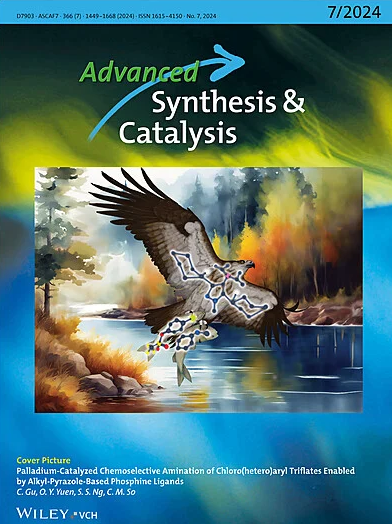Asymmetric Strategies for the Synthesis of Enantiopure α‐/β‐/γ‐Thio‐Carboxylic Acids Bearing a Stereocentre at CS Bond
IF 4
2区 化学
Q2 CHEMISTRY, APPLIED
引用次数: 0
Abstract
Enantiomerically pureC - S键上具有立体中心的对映纯α‐/β‐/γ‐硫代羧酸的不对称合成策略
在C-S键上具有立体中心的对映体纯α‐/β‐/γ‐硫代羧酸是一类在有机化学和药物化学中具有重要意义的化合物。C-S键的手性在合成化学中既是挑战也是机遇。传统上,这些α‐/β‐/γ‐硫代羧酸的对映选择性合成依赖于使用天然衍生前体(如氨基酸和羟基羧酸)的手性池策略。近年来,有机和金属催化方法的发展,如金鸡纳生物碱、铜和铑配合物等催化剂,提高了效率和立体控制的策略。此外,生物催化技术的进步使水解酶和腈酶等酶能够更可持续地合成这些有价值的化合物。鉴于学术界和工业界对这些化合物的兴趣日益浓厚,本文综述了过去二十年来在C-S键上具有立体中心的硫代羧酸的不对称合成方法的发展和取得的进展。
本文章由计算机程序翻译,如有差异,请以英文原文为准。
求助全文
约1分钟内获得全文
求助全文
来源期刊

Advanced Synthesis & Catalysis
化学-应用化学
CiteScore
9.40
自引率
7.40%
发文量
447
审稿时长
1.8 months
期刊介绍:
Advanced Synthesis & Catalysis (ASC) is the leading primary journal in organic, organometallic, and applied chemistry.
The high impact of ASC can be attributed to the unique focus of the journal, which publishes exciting new results from academic and industrial labs on efficient, practical, and environmentally friendly organic synthesis. While homogeneous, heterogeneous, organic, and enzyme catalysis are key technologies to achieve green synthesis, significant contributions to the same goal by synthesis design, reaction techniques, flow chemistry, and continuous processing, multiphase catalysis, green solvents, catalyst immobilization, and recycling, separation science, and process development are also featured in ASC. The Aims and Scope can be found in the Notice to Authors or on the first page of the table of contents in every issue.
 求助内容:
求助内容: 应助结果提醒方式:
应助结果提醒方式:


